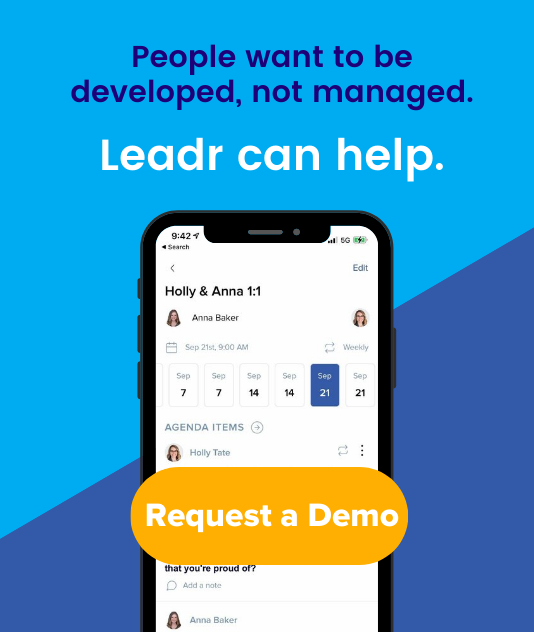Putting Plans Into Action: 3 Things To Do After Your Performance Review
You can take a deep breath - the performance review conversation is over. While it’s our dream that the annual performance review conversation becomes less stressful as you adopt a new mindset, we know it may take some time before these feel like a comfortable, forward-focused conversation and less like being put under a microscope for everything that happened in the past year.
Regardless of how it went, give yourself a high five! The hard part is over. Your next step is to start dreaming and planning - and that’s the fun part. When you’re having a conversation about the past year and looking ahead to the next one with your boss or team, it’s easy to dream big and set lofty goals in performance review meetings. But how do you stick to the plan every day after?
Here are the top three things you should do right now to set yourself up for a great year that helps you put dreams into action and focuses you toward growth throughout the next year:
1. Make your goals visible.
One of the best ways to keep track of your goals and progress is to make sure you see them every day! Write them down on a whiteboard or in a planner, anywhere that you’ll be able to reference them easily and quickly. One great method is to break big goals into smaller tasks - what do you need to do to get to this point or reach this goal - or stretch yourself? Consider writing those down on a sticky note and ripping up the sticky note each time you complete a step. Being able to see progress like that is powerful motivation and encouragement no matter what obstacles you inevitably face.
2. Talk about your goals.
We’re not just talking about updating your boss or team on how things are going - but raise your hand if you think your supervisor or someone in your organization could help you reach a goal. Want to step into more leadership on your own team? Bring it up with your supervisor and take the initiative. They’ll appreciate that you are seeing opportunities for growth and be able to have more focused coaching conversations.
At Leadr, we believe a custom leadership development track for every employee is one of the quickest routes to growth. Leadership programs allow potential leaders to read, discuss, and meet with others to talk about leadership strategies and create a personalized journey that combines their unique strengths with their passion for growth. Bringing up your goals can help others know how to help you and create a beneficial growth path for you.
Bringing up goals and discussing them in every single one on one can also help build a rhythm of feedback and accountability, especially when it comes to accomplishing smaller tasks on the way to a bigger goal. Your team is behind you and they’re there for you if you get off track a little bit or need to refocus or rethink a goal. That transparent two-way feedback can help you clarify and confirm that you’re where you need to be and help others grow too.
3. Be flexible.
Agree to be flexible if your goals change. At the end of the day, goals are set to benefit the organization's mission. If at some point your goals don’t move the needle for the bigger picture, be willing to have open conversations with your manager and change them.
At the same time, don’t let the tyranny of the urgent distract you. There’s a fine line between being flexible and being focused. When side projects or unplanned tasks do come up, always question what will have to be sacrificed to make room for the new project.
Each time this happens, rather than always saying “yes” to every shiny new idea or stressing about getting it all done, take it to your manager. Let them know, “X came up. I can get that done but it may mean sacrificing my goal of Y. Here’s what I think we should do. What are your thoughts?”
Lead with a yes by coming to your manager with a solution in mind, rather than just the problem. The practice of leading with a yes also helps you incorporate a growth mindset and become proactive instead of reactive when challenges arise. Leading with a yes doesn’t always mean you take on everything and burn out - but rather, it means you consider how a new project or different way of doing something fits into the overall goal. Would it help to change? Try it! Did something not work? Then ask, “what can we do differently next time that would change this outcome?” instead of saying “no we’re not doing that.”
These three habits are easy steps that you can start to build into the rhythms of your one on one meetings and feedback conversations. We hope by the time your next performance review rolls around, you can look back on the past year and see all the growth, agility and subsequent confidence and success that grew out of practicing these habits.
Did you know you can do performance reviews in Leadr? We love memorializing our goals in these meetings, but we also know how important it is to revisit your goals frequently. That’s why we make it easy for you to copy topics, questions, goals, assignments, and anything else you record in your reviews to your other meetings in Leadr. If goal setting is tough for you, speak with our team to see Leadr in action. See if it can help you reach your goals.
Share this
You May Also Like
These Related Stories

Are Performance Reviews Outdated?

Clarity: A Critical Component For High-Performing Teams






No Comments Yet
Let us know what you think